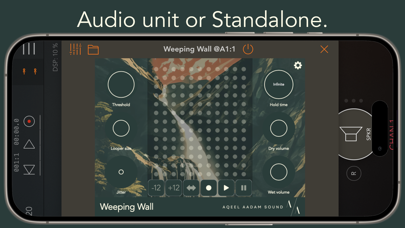| 現在の価格 | ¥ 700(2024/11/21 更新) |
| カテゴリ | ミュージック |
| 評価 |
(0)
|
| 対応デバイス | iPhone |


Weeping Wall is a standalone app and AUv3 plug-in. WW is a set of microloopers that automatically record based on input detection. Each new sound will be smoothly introduced and replace older sounds, resulting in a group of sounds that always reflect the most recent input. Each looper behaves independently - their size can vary and they will beat against each other as they phase. Up to 5 loopers are available to record into, with repitching and reverse controls as well. A dedicated “jitter” control allows you to randomly vary the size of each looper on each loop, creating variations that will never be heard again.
Weeping Wall can be used as an effect directly on a track, or as a send effect. WW is intended to be a modular tool; it doesn’t include reverb, EQ, saturation, flutter, etc., but it plays extremely well with them. WW is a brand new effect that can be used in any number of creative ways - you can place it fully wet in front of a reverb, place a hint of it behind a saturator, combine it with your favorite pitch modulation - whatever you can dream. WW is fully compatible with automation and modulators such as Ableton CV to broaden the horizons even further.
Weeping Wall has the following controls available:
Threshold: The volume at which input will start recording into a looper.
Looper size: The size of loopers, in seconds, from 0.1s to 3s.
Jitter: A control for desynchronizing loops. Loops will be randomly shortened, and each one is free to change size independent of one another.
Semitones: Repitch loops, with a range of +/- one octave.
Reverse: A latching control to reverse looper playback.
Looper number: Up to five loopers are available.
Hold time: How long loops will be held before fading away, from seconds to forever. This essentially controls whether WW functions more as a looper or as a delay.
Independent dry and wet volumes: Use WW as an effect directly on your track, or as a send effect.
Beat syncing: Loopers can be synced to your tempo, from 1 whole measure to 1/64th notes.
Macro-looper mode: Loops can grow to up to 60 seconds in length.
Transport syncing: Loopers can be paused or destroyed on pause.
Live performance mode: Enables a button-based UI designed with live performance in mind.
Random skip: Loops can be randomly skipped over with some probability.
Crossfade length: Control the length of the crossfade occurring at the start/end of each loop to keep sharper transients or smooth them off.
Fade time: Control how long loops take to fade in/out.
Filters: The wet channel can be high or low pass filtered for dialing in your sound.
Weeping Wall can be used as an effect directly on a track, or as a send effect. WW is intended to be a modular tool; it doesn’t include reverb, EQ, saturation, flutter, etc., but it plays extremely well with them. WW is a brand new effect that can be used in any number of creative ways - you can place it fully wet in front of a reverb, place a hint of it behind a saturator, combine it with your favorite pitch modulation - whatever you can dream. WW is fully compatible with automation and modulators such as Ableton CV to broaden the horizons even further.
Weeping Wall has the following controls available:
Threshold: The volume at which input will start recording into a looper.
Looper size: The size of loopers, in seconds, from 0.1s to 3s.
Jitter: A control for desynchronizing loops. Loops will be randomly shortened, and each one is free to change size independent of one another.
Semitones: Repitch loops, with a range of +/- one octave.
Reverse: A latching control to reverse looper playback.
Looper number: Up to five loopers are available.
Hold time: How long loops will be held before fading away, from seconds to forever. This essentially controls whether WW functions more as a looper or as a delay.
Independent dry and wet volumes: Use WW as an effect directly on your track, or as a send effect.
Beat syncing: Loopers can be synced to your tempo, from 1 whole measure to 1/64th notes.
Macro-looper mode: Loops can grow to up to 60 seconds in length.
Transport syncing: Loopers can be paused or destroyed on pause.
Live performance mode: Enables a button-based UI designed with live performance in mind.
Random skip: Loops can be randomly skipped over with some probability.
Crossfade length: Control the length of the crossfade occurring at the start/end of each loop to keep sharper transients or smooth them off.
Fade time: Control how long loops take to fade in/out.
Filters: The wet channel can be high or low pass filtered for dialing in your sound.
